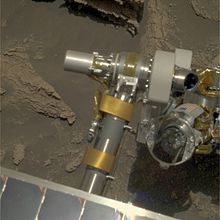Honeybee Robotics
This article needs to be updated. (January 2020) |
| Founded | New York, NY, USA (1983) |
|---|---|
| Founders |
|
| Headquarters | , |
Number of locations | 3 Locations (2017) |
| Parent | Ensign-Bickford Company |
Honeybee Robotics Spacecraft Mechanisms Corporation is a small spacecraft technology and robotics company [1] headquartered in Brooklyn, New York, with offices in Altadena, California and Longmont, Colorado.[2] It was established in 1983 by Stephen Gorevan [3] and Chris Chapman.[4] In June 2017, Honeybee Robotics was acquired by Ensign-Bickford Industries.[5][6]
Products[]
Honeybee has particular expertise in developing and operating small mechanical tools used on Mars missions. Some of the robotic devices it has developed and successfully demonstrated on Mars include:
- The Rock Abrasion Tool (RAT) instruments used on both Mars Exploration Rovers [7]
- The Icy Soil Acquisition Device (ISAD), sometimes called the "Phoenix Scoop",[8] a soil scoop and a precision ice-sampling tool successfully demonstrated on the 2008 Mars Phoenix Lander mission
- The Sample Manipulation System and Dust Removal Tool used on the Mars Science Laboratory mission, which landed in August 2012 [9]

In addition, they were developing tools that would be used to live and work on the moon as part of NASA's Constellation program.[10] They are now helping design instruments for NASA's VIPER rover.
Honeybee develops systems for future missions to Mars,[11] Venus, the Moon, two Jovian moons,[11] and asteroid [12] and comet sample return,[13] among others. They worked with Bigelow Aerospace to develop a preliminary design for a solar array deployment mechanism that was used on the solar arrays of their Genesis inflatable space habitat. Terrestrial projects include developing mechanisms, installations, and systems for a broad array of clients including Con Edison, the U.S. Navy, Coca-Cola, Nike, and architects Diller Scofidio + Renfro.[14]
References[]
- ^ Erik Baard, "Alligators Below City? Try Robo-Inchworms" The New York Times BUSINESS: DIARY; November 10, 2002
- ^ "Locations". Honeybee Robotics. Retrieved 2 June 2016.
- ^ Kenneth Chang, "Martian Robots, Taking Orders From a Manhattan Walk-Up," The New York Times November 7, 2004
- ^ Greg Clark, "Mars Sample Mission -- Here's the Drill Archived 2001-02-12 at the Wayback Machine" SPACE.com, posted August 11, 1999
- ^ "Ensign-Bickford Industries, Inc. Acquires Honeybee Robotics » Ensign-Bickford Aerospace & Defense Company". 22 July 2017. Archived from the original on 22 July 2017. Retrieved 5 March 2021.
- ^ "Honeybee Robotics Has Been Acquired By Ensign-Bickford Industries". Colorado Space News. 6 July 2017. Retrieved 5 March 2021.
- ^ "Touch and Go Days - Astrobiology Magazine". astrobio.net. 7 February 2004. Retrieved 2 June 2016.
- ^ "Sample Processing, Manipulation & Containment". honeybeerobotics.com. Archived from the original on 2 June 2008. Retrieved 2 June 2016.
- ^ NASA.gov
 This article incorporates text from this source, which is in the public domain.
This article incorporates text from this source, which is in the public domain.
- ^ "How to build lunar homes from moon dirt". USA TODAY. Retrieved 2 June 2016.
- ^ Jump up to: a b K. Zacny, G. Paulsen, K. Davis, E. Mumm, and S. Gorevan, Honeybee Robotics Planetary Sample Acquisition, Transfer and Processing Technologies, presented at Mars Sample Return 2008, Lunar and Planetary Science Institute
- ^ Derek Sears, Carl Allen, Dan Britt, Don Brownlee, Melissa Franzen, Leon Gefert, Stephen Gorovan, Carle Pieters, Jeffrey Preble, Dan Scheeres and Ed Scott, "The Hera mission: multiple near-earth asteroid sample return" Advances in Space Research, Volume 34 Issue 11, 2004, pp. 2270-2275 doi:10.1016/j.asr.2003.05.059
- ^ S. Gorevan, I. Yachbes, P. Bartlett, K.Zacny, G. L. Paulsen, T. Kennedy, B. Basso, and J. Wilson, "Comet and Asteroid Sample Acquisition, Containerization, and Transfer for Sample Return" presented at Spacecraft Reconnaissance of Asteroid and Comet Interiors (2006)
- ^ "Our mission". Honeybee Robotics. Archived from the original on 26 March 2006. Retrieved 2 June 2016.
External links[]
- Aerospace companies of the United States
- Robotics companies of the United States
- Technology companies established in 1983
- Companies based in Brooklyn